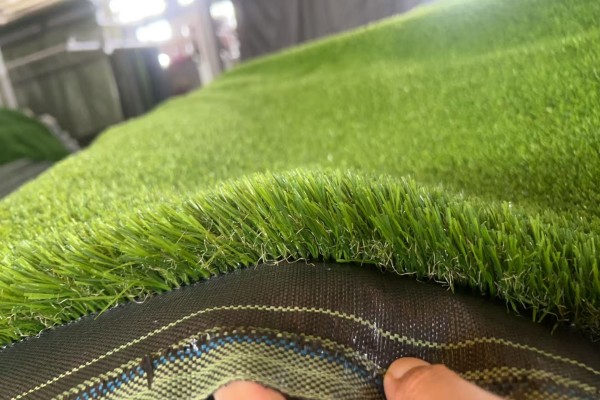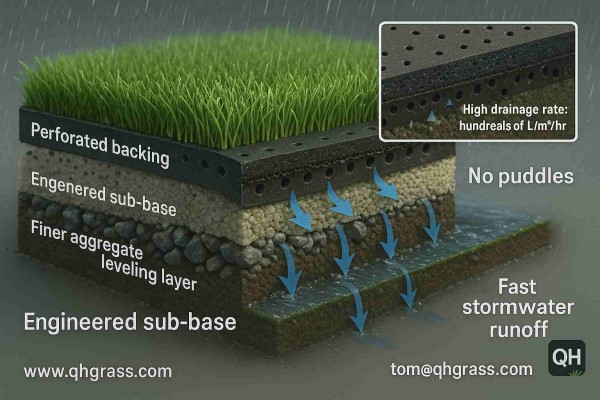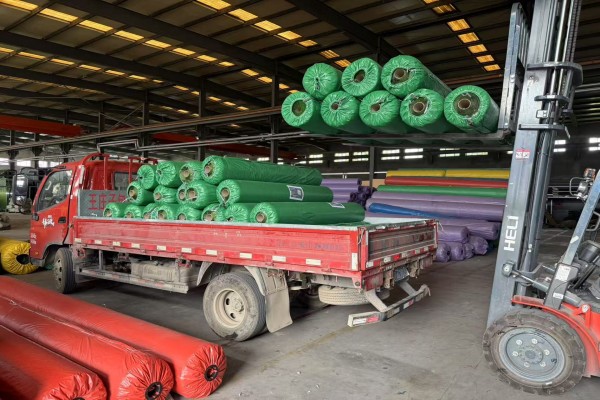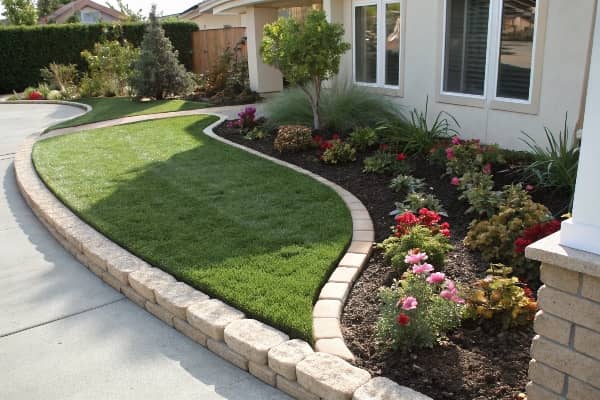Tired of endless weeding? You dream of a perfect lawn but fear that seeds will ruin your new artificial turf. The truth is simpler than you think.
Seeds cannot grow on the plastic fibers of artificial turf. However, if dirt and organic debris build up on the surface or in the infill, airborne seeds can land and sprout in that debris. Regular maintenance is the key to preventing this.

This seems straightforward, but it’s a question I get all the time from customers. The answer touches on the difference between things growing on the turf versus things growing through it. The quality of your turf and, more importantly, the quality of the installation, makes all the difference. To give you a complete picture, we need to look at how a complete artificial turf system works from the ground up. Let’s break down the most common questions I get to put your mind at ease.
Do weeds grow through artificial turf?
Worried that determined weeds will push through your new turf? It’s a common fear, but a professional installation1 is specifically designed to stop them from ever seeing sunlight.
No, weeds should not grow through properly installed artificial turf. The combination of a compacted sub-base and a durable turf backing, often paired with a weed barrier membrane, effectively blocks weed growth from coming up from the soil underneath.

When I help clients plan their projects, I always emphasize that the work done before the turf is laid is just as important as the turf itself. A great artificial grass system is built in layers, and each layer has a job. Preventing weed growth is a primary goal.
The Sub-Base Foundation
First, we clear the area of all existing grass and weeds. Then we build a sub-base, usually with several inches of crushed rock or aggregate. We compact this base until it’s firm and stable. This dense, compacted layer is physically difficult for weed roots to penetrate. I once had to fix a project for a client who hired a cheap contractor. The contractor just laid the turf on top of the soil. Within a year, the surface was lumpy and weeds were popping up everywhere. This is why the sub-base is not a step you can skip.
The Weed Barrier Membrane
On top of the compacted sub-base, we often lay a high-quality geotextile fabric, also known as a weed barrier. This material allows water to drain through it, which is essential for any outdoor installation. But it blocks sunlight from reaching the soil below. Without sunlight, dormant weed seeds in the soil cannot germinate and grow. It’s a simple, effective solution.
The Turf’s Own Backing
Finally, the artificial turf itself has a tough, durable backing. This is usually made of multiple layers and coated with polyurethane or latex. This backing is the final shield, providing another strong barrier that weeds cannot easily push through.
| Installation Step | Poor Installation | Professional QH Grass Installation |
|---|---|---|
| Ground Prep | Laid directly on soil | Excavated and cleared of all vegetation |
| Base Layer | Thin layer of sand or nothing | 4-6 inches of compacted aggregate |
| Weed Control | None | High-quality geotextile weed barrier |
| Result | Lumpy surface, weeds within months | Smooth surface, long-term weed prevention |
Do artificial turf grow?
The name "artificial grass" can sometimes be confusing. Does it need to be mowed or watered to keep it alive? Let’s clear up this very basic but important question once and for all.
No, artificial turf does not grow. It is a completely synthetic, manufactured product made from plastic and rubber components. It has no biological parts, so it cannot grow, die, or need sunlight like real grass.

This might seem like a simple question, but understanding why it doesn’t grow helps you understand the product better. In my early days working in the technical department of a turf factory, I was fascinated by the manufacturing process. It’s a product of engineering, not nature.
What the "Blades" Are Made Of
The green blades that look like grass are made from plastic polymers. The most common ones are Polyethylene (PE) and Polypropylene (PP).
- Polyethylene (PE): This is used for most of the yarn because it’s soft to the touch, gentle on the skin, and very resilient. It’s what gives quality turf its realistic feel.
- Polypropylene (PP): This is a stiffer plastic. It’s often used for the "thatch layer," a curly, shorter yarn mixed in to help the main blades stand up and to give the grass more body.
These plastic pellets are melted down and pushed through a tool called an extruder to create the yarn in specific shapes and colors. We also add UV inhibitors during this process. This is critical because it protects the plastic from the sun’s rays, preventing the colors from fading over time.
The Structure That Holds It Together
The yarn is then tufted into a backing material, much like making a carpet. This backing system has two parts:
- Primary Backing: The fabric that the yarn is stitched into.
- Secondary Coating: A strong coating, usually polyurethane, applied to the back to lock the stitches in place and add strength and stability.
There is nothing living in this entire system. It’s designed for durability and appearance, not biological growth.
| Component | Material | Key Function |
|---|---|---|
| Blades | Polyethylene (PE) | Softness, realism, comfortable feel |
| Thatch | Polypropylene (PP) | Support, structure, enhanced durability |
| Backing | Woven fabrics + Polyurethane | Locks in blades, provides strength |
| Additives | UV Inhibitors | Prevents color fading from sunlight |
Can you plant plants in artificial grass?
You want a perfect, maintenance-free lawn but miss the look of real flowers or shrubs. Many of my clients think it’s an all-or-nothing choice. The good news is, you can beautifully integrate real plants with your artificial turf.
You cannot plant directly into artificial grass because there is no soil. However, you can easily create dedicated garden beds by cutting away sections of the turf and preparing a proper planting area underneath. This creates a clean, integrated landscape.

Combining the green of artificial turf with the colors and textures of living plants creates a stunning, high-impact landscape that is still very low-maintenance. The process is straightforward if you plan for it. I’ve guided many customers through this, and the results are always fantastic.
Step 1: Design and Mark Your Garden Beds
First, decide where you want your plants. You can create beds around trees, along a fence, or as an island in the middle of your lawn. Use a rope or marking paint to outline the exact shape you want.
Step 2: Cut the Turf and Prepare the Base
Once the turf is laid, use a sharp utility knife to carefully cut along the marked lines. Roll back the section of turf you are removing. Next, you need to dig out the sub-base material (the crushed rock) from that area. You need to create a space for soil.
Step 3: Create a Border
This is a critical step that many people overlook. You must install a border between the turf and the new garden bed. You can use bender board, stone, or metal edging. This border does two things: it keeps the soil and mulch from spilling onto your turf, and it provides a clean, secure edge to fasten the turf against. It makes the whole project look professional.
Step 4: Add Soil and Plants
Fill the new bed with quality topsoil and compost. Now you can add your flowers, shrubs, or other plants just like you would in any other garden. After planting, you can add a layer of mulch to help retain moisture and keep the area looking tidy. The contrast between the perfect green turf and the natural, living plants is what makes this design so successful.
Conclusion
Artificial turf is a non-living product, so it won’t grow. With a proper installation and basic cleaning, you can enjoy a beautiful, low-maintenance lawn without worrying about weeds.
-
Discover why professional installation is essential for achieving a long-lasting and effective artificial turf system. ↩
_画板-1.png)
_画板-1.png)